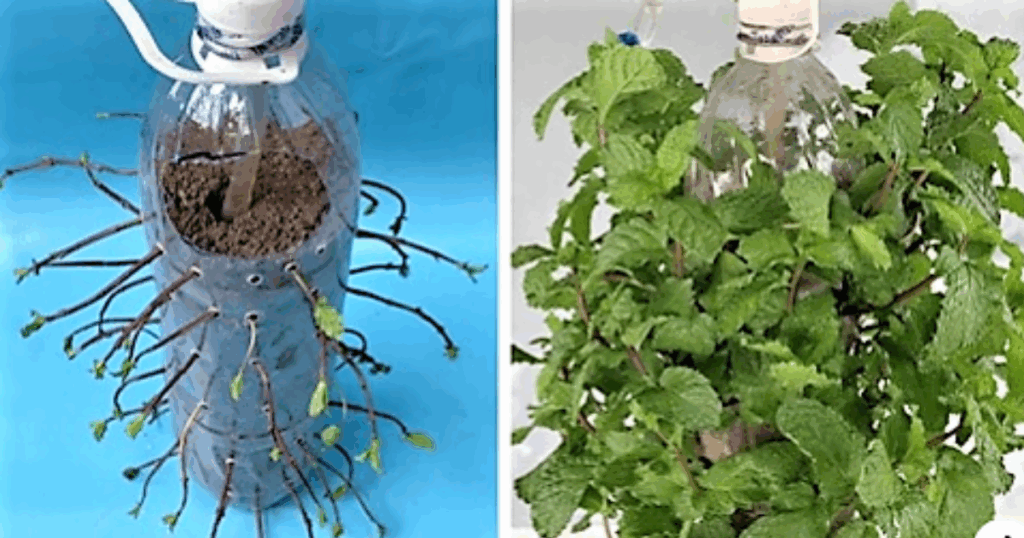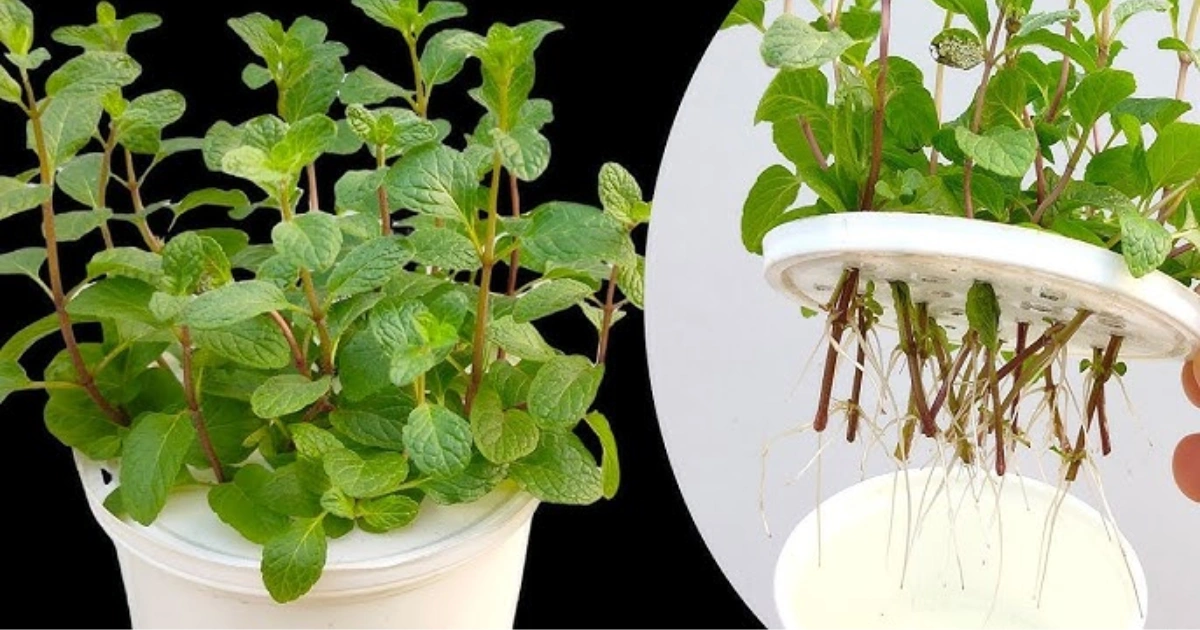If you’re passionate about herbs and gardening, cultivating your own mint is a rewarding experience. Mint, with its aromatic leaves and versatile uses, is a delightful addition to any garden or kitchen. However, mint can be invasive if not managed properly. Fortunately, there’s a clever technique that simplifies the process and ensures your mint thrives without taking over your space. This method also works wonders for other herbs.
🌱 Why Grow Mint and Other Herbs?
Mint and herbs, in general, offer numerous benefits:
- Versatility: Mint comes in various flavors, including peppermint, spearmint, and chocolate mint, each with its unique taste and aroma. This versatility makes mint an excellent addition to a wide range of dishes, from salads and beverages to desserts.
- Medicinal Properties: Mint is renowned for its medicinal properties, including aiding digestion, soothing headaches, and reducing nausea. Many other herbs also have valuable medicinal properties.
- Aesthetic Appeal: Mint is visually appealing with its vibrant green leaves, making it an excellent choice for ornamental gardens. Herbs, in general, can add a touch of beauty to any garden.
🛠️ The Plastic Cup Method: A Smart Way to Grow Mint and Other Herbs
The “plastic cup method” is an innovative technique that provides your mint plants with consistent nourishment while minimizing the risk of overwatering. Here’s a step-by-step guide to implementing this method:
Materials Needed:
- A suitable pot or container of your choice.
- Potting soil or garden soil mix.
- A perforated plastic cup.
- Mint cuttings, herbs, or young plants.
- Natural fertilizers such as garlic and banana peels.
- Water.
Step-by-Step Guide:
- Prepare Your Container: Select a container large enough to accommodate your plants. Mint and some other herbs can be invasive, so containment is essential. Fill the container with potting soil or a garden soil mix, leaving enough space for the plastic cup.
- Prepare the Perforated Cup: Take a plastic cup and create small holes in the sides and bottom. These holes will allow water and nutrients to gradually disperse into the soil, promoting even moisture and nutrient distribution.
- Place the Plastic Cup: Bury the perforated plastic cup in the center of the container. Position it so that the rim of the cup aligns with the soil surface, resembling an ‘o’ from above. This facilitates the easy addition of water and fertilizers.
- Incorporate Fertilizers: Fill the plastic cup with a blend of crushed garlic and banana peels or other natural fertilizers. These will release vital nutrients slowly into the soil, providing your plants with the nourishment they require.
- Plant Mint or Other Herbs: Surround the plastic cup with your mint cuttings, herb seedlings, or young plants. Ensure they have sufficient space to grow while benefiting from the nutrients within the cup.
- Watering: To water your mint or herbs, simply pour water directly into the plastic cup. The water will seep through the cup’s holes, transporting the nutrients from the garlic and banana peels into the soil, enriching it and nourishing the plant roots.
- Maintenance: Mint and most herbs are relatively low-maintenance, but it’s crucial to monitor them. Regularly check the plastic cup to confirm an adequate water and fertilizer supply. Water the plants surrounding the cup as necessary to maintain consistently moist soil without overwatering.
🚫 Common Mistakes and How to Avoid Them
- Refrigerating Green Bananas: Placing unripe bananas in the refrigerator can halt the ripening process and result in a poor texture when they eventually ripen.
- Storing with Other Ethylene-Producing Fruits: Keeping bananas near apples or avocados can cause them to ripen too quickly due to the ethylene gas emitted by these fruits.
- Using Enclosed Containers: Storing bananas in plastic bags or sealed containers can trap ethylene gas and accelerate ripening.

🌿 Benefits of the Plastic Cup Method
- Reduced Food Waste: By extending the freshness of bananas, you can consume them before they spoil.
- Cost Savings: Proper storage methods can save money by reducing the need to purchase bananas frequently.
- Nutritional Value: Fresh bananas retain their potassium, vitamin B6, and vitamin C content, contributing to a healthy diet.
🌍 Seasonal and Regional Tips
In warmer climates, such as Algeria, bananas ripen faster due to higher temperatures. To counteract this, consider the following tips:
- Purchase Green Bananas: Buying bananas that are still green allows you to control the ripening process.
- Use Cooling Methods: Employing methods like refrigeration (once ripe) or freezing can help preserve bananas longer in hot climates.
🧰 Tools and Materials Checklist
- Plastic wrap or foil
- Fruit hanger or hook
- Parchment paper
- Freezer-safe bags or containers
- Glass jar with lid
🍞 Recipe: Simple Banana Bread
Utilize your ripe bananas with this easy and delicious banana bread recipe, perfect for breakfast or a snack.
Ingredients:
- 3 ripe bananas, mashed
- 1/3 cup melted butter
- 1 teaspoon baking soda
- Pinch of salt
- 3/4 cup sugar (adjust to taste)
- 1 large egg, beaten
- 1 teaspoon vanilla extract
- 1 1/2 cups of all-purpose flour
Instructions:
- Preheat Oven: Preheat your oven to 350°F (175°C). Grease a 4×8-inch loaf pan.
- Mix Ingredients: In a mixing bowl, combine the mashed bananas and melted butter. Stir in the baking soda and salt. Add the sugar, beaten egg, and vanilla extract, mixing well. Gradually blend in the flour.
- Bake: Pour the batter into the prepared loaf pan. Bake for 50 minutes to 1 hour, or until a tester inserted into the center comes out clean.
- Cool and Serve: Let the bread cool in the pan for a few minutes, then transfer it to a wire rack to cool completely before slicing.
❓ Frequently Asked Questions
Q: Can I store bananas in the refrigerator?
A: Yes, once bananas are ripe, placing them in the refrigerator can slow down further ripening. However, the peel may darken.
Q: How can I ripen bananas faster?
A: Place bananas in a paper bag with an apple or avocado. The ethylene gas emitted will speed up the ripening process.
Q: Can I freeze whole bananas?
A: Yes, peel and freeze whole bananas for later use in smoothies or baking.
📝 Conclusion
By implementing these simple storage methods, you can significantly extend the freshness of your bananas, reducing waste and ensuring you always have this healthy, tasty fruit on hand. Whether you enjoy them as a quick snack, in smoothies, or baked into delectable treats like banana bread, these strategies will help you get the most out of every bunch.


https://t.me/s/flagman_official_registration
https://t.me/s/BeeFcAsiNo_OffIcIaLS